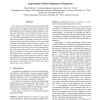Free Online Productivity Tools
i2Speak
i2Symbol
i2OCR
iTex2Img
iWeb2Print
iWeb2Shot
i2Type
iPdf2Split
iPdf2Merge
i2Bopomofo
i2Arabic
i2Style
i2Image
i2PDF
iLatex2Rtf
Sci2ools
BIBE
2005
IEEE
2005
IEEE
Approximate Global Alignment of Sequences
We propose two novel dynamic programming (DP) methods that solve the the approximate bounded and unbounded global alignment problems for biological sequences. Our first method solves the bounded alignment problem. It computes the distribution of the edit distance between the remaining suffixes. For a given bound k and approximation p %, it uses this distribution to prune the entries of the DP matrix that will lead to alignments with more than k edit operations with more than p% probability. Our second method addresses the unbounded global alignment problem. For each entry of the distance matrix, it dynamically computes an upper bound to the distance between the unaligned suffixes. This bound, along with the lower bound as computed for the bounded case, is then used to eliminate the entries of the distance matrix. According to our experimental results, our methods are up to three times faster than the competing methods for the bounded alignment and up to two times faster for the unb...
Alignment Problem | BIBE 2005 | Bioinformatics | Global Alignment Problem | Unbounded Global Alignment |
| Added | 24 Jun 2010 |
| Updated | 24 Jun 2010 |
| Type | Conference |
| Year | 2005 |
| Where | BIBE |
| Authors | Tamer Kahveci, Venkatakrishnan Ramaswamy, Han Tao, Tao Li |
Comments (0)

